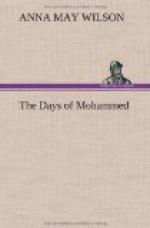The Arabs screamed, helpless before the manifestation of what they believed was a supernatural force, for they look upon these columns as the evil genii of the plains. Men and camels fell to the ground. Horses neighed in fear, and galloped madly to and fro. But the hot breath of the “poison-wind” was upon them in a moment, shrieking like a fiend among the crisping acacias. The sand-storm then fell in all its fury, half smothering the poor wretches, who strove to cover their heads with their garments to keep out the burning, blistering, pitiless dust.
Fortunately all was over in a moment, and the tempest went swirling on its way northward, leaving a clear sky and a dust-buried country in its wake.
In the confusion the dervish had escaped to the other end of the caravan, and was forgotten.
At the end of the tenth day after leaving Medina the caravan reached the head of the long, narrow defile in which lies the city of Mecca, the chief town of El Hejaz. It was early morning when the procession passed through the cleft at the western end; and the sun was just rising, a globe of red, above the blue mountains towards Tayf, when Yusuf stopped his camel on an eminence in full view of the city. There it lay in the heart of the rough blackish hills, whose long shadows still fell upon the low stone houses and crooked streets beneath.[5]
The priest’s eager glance sought for the Caaba. There it was, a huge, stone cube, standing in the midst of a courtyard two hundred and fifty paces long by two hundred paces wide, and shrouded from top to bottom by a heavy curtain of dark, striped cloth of Yemen.
There was something awe-inspiring in the scene, and the priest felt a thrill of apprehensive emotion as he gazed upon what he had fondly hoped would prove the end of his long journey. Yet his eye clouded; he covered his face with his mantle and wept, saying to his soul, “Here, too, have they turned aside to worship the false, and have bowed down to idols! My soul! My soul! Where shalt thou find truth and rest?”
Amzi touched him on the arm. “Why do you weep, friend? Thou art a false Guebre, truly! Know you not that even they hold the Caaba in high reverence?”
There was a tone of good-natured raillery in the voice, and the speaker continued: “Arouse yourself, my friend. See how they worship in Mecca. They are at it already! See them run! By my faith ’tis a lusty morning exercise!”
Yusuf looked up to see a great concourse of people gathering in the court-yard. Many were rushing about the Caaba, and pausing frequently at one corner of the huge structure.
“Each pilgrim,” explained Amzi, “holds himself bound to go seven times about the temple, and the harder he runs the more virtue there is in it—performing the Tawaf, they call it. Those who seem to pause are kissing the Hajar Aswad—the Black Stone, which, the Arabs say, was once an angel cast from heaven in the form of a pure white jacinth. It is now blackened by the kisses of sinners, but will, at the last day, arise in its angel form, to bear testimony of the faithful who have kissed it, and have done the Tawaf faithfully. And now, friend, come to the house of Amzi, and see if he can be as hospitable as Musa the Bedouin.”




